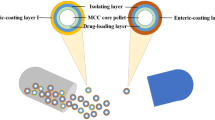Summary
Two multiple-units controlled-release indomethacin capsule formulations containing enteric-coated pellets were bioequivalent to a standard capsule formulation (taken as the reference) in respect of extent of bioavailability in a crossover study with normal human subjects. However, drug absorption from the enteric-coated pellet formulations was slower, when compared to that from the standard reference capsule. The standard reference capsule released 85% of its drug content in vitro during 10 min at pH 6.5 and 98% during 1 h at pH 7.5. One enteric-coated pellet capsule formulation (I) released 77% during 1 h at pH 6.5 and the other (II) released 10% during 1 h at pH 6.5. Release of drug from each capsule of enteric-coated pellets was complete during 1 h at pH 7.5. Although differences in areas under the plasma indomethacin concentration-time curves were not significantly different, the peak plasma levels and the times of their occurrence indicated that the absorption rates of indomethacin decreased in the order, reference formulation > pellet formulation I > pellet formulation II, which was the same rank order as that of their dissolution rates in vitro. The data indicated that multiple units controlled-release formulations represent a reliable and reproducible source of indomethacin, which by avoiding extremes of local or systemic drug concentrations also should be better tolerated by individuals susceptible to unwanted gastrointestinal and centrally-mediated side-effects.
Similar content being viewed by others
References
Goodman LS, Gilman A (1980) The pharmacological basis of therapeutics. McMillan, New York, p 706
Boardman PL, Hart FD (1967) Side-effects of indomethacin. Ann Rheum Dis 26: 127–132
Rothermich NO (1966) An extended study of indomethacin. J Am Med Assoc 195: 531–536
Alván G, Orme M, Bertilsson L, Ekstrand R, Palmér L (1975) Pharmacokinetics of indomethacin. Clin Pharmacol Ther 18: 364–373
Holt LPJ, Hawkins CF (1965) Indomethacin: studies of absorption and of the use of indomethacin suppositories. Br Med J 1: 1354–1356
Caruso I, Bianchi Porro G (1980) Gastroscopic evaluation of anti-inflammatory agents. Br Med J 1: 75–78
Donnelly P (1980) Indomethacin and perforated duodenal ulcer. Br Med J 2: 230
Bechgaard H, Hegermann Nielsen G (1978) Controlled Release multiple-units and single-unit doses. A literature review. Drug Dev Ind Pharm 4: 53–67
Blythe RH, Grass GM, McDonnel DR (1959) The formulation and evaluation of enteric coated aspirin tablets. Am J Pharm 131: 206–216
Wagner JG, Veldkamp W, Long S (1960) Enteric coatings IV. In vivo testing of granules and tablets coated with styrenemaleic acid copolymer. J Am Pharm Assoc Sci Ed 49: 128–132
Leonards JR, Levy G (1965) Absorption and metabolism of aspirin administered in enteric-coated tablets. J Am Med Assoc 193: 99–104
Wiik I, Sveen K, Renaa T, Dramsrud L (1975) In vitro dissolution and in vivo absorption of different acetylsalicylic acid tablets following single dose administration. Medd Nor Farm Selsk 37: 21–49
Bogentoft C, Carlsson I, Ekenved G, Magnusson A (1978) Influence of food on the absorption of acetylsalicylic acid from enteric-coated dosage forms. Eur J Clin Pharmacol 14: 351–355
Benet LZ (1973) In: Ariëns EJ (ed) Drug design, Vol 4. Academic Press, New York London, pp 1–35
Green DM (1966) Tablets of coated aspirin microspherules — A new dosage form. J New Drugs 6: 294–303
Green MA (1954) One years experience with sustained release anti-histamine medication. Ann Allergy 12: 273–283
Feinblatt TM, Gerguson EA (1956) Timed-disintegration capsules. An in vivo roentgenographic study. N Engl J Med 254: 940–943
Feinblatt TM, Ferguson EA (1957) Timed-disintegration capsules (Tymcaps) — A further study. An in vivo roentgenographic study, blood-level study and relief of anginal pain with pentaerythritol tetranitrate. N Engl J Med 256: 331–335
Casey DL, Beihn RM, Digenis GA, Shambhu MB (1976) Method for monitoring hard gelatine capsules disintegration times in humans using external scintigraphy. J Pharm Sci 65: 1412–1413
Bechgaard H, Ladefoged K (1978) Distribution of pellets in the gastrointestinal tract. The influence on transit time exerted by the density or diameter of pellets. J Pharm Pharmacol 30: 690–692
Bergdahl B, Bogentoft C, Jonsson UE, Magnusson JO (1980) Absorption of digoxin from a new microencapsulated formulation. Eur J Clin Pharmacol 17: 443–447
The national formulary XIV (1975) Mack Publishing Co., Easton, PA, p 985
Snedecor GW, Cochran WG (1967) Statistical methods. Iowa State University Press, Iowa, pp 271–275
Cochran WG (1950) The comparison of percentages in matched samples. Biometrika 37: 256–266
Metzler C (1974) Bioavailability — a problem in equivalence. Biometrics 30: 309–317
Author information
Authors and Affiliations
Rights and permissions
About this article
Cite this article
Bechgaard, H., Brodie, R.R., Chasseaud, L.F. et al. Bioavailability of indomethacin from two multiple-units controlled-release formulations. Eur J Clin Pharmacol 21, 511–515 (1982). https://doi.org/10.1007/BF00542047
Received:
Accepted:
Issue Date:
DOI: https://doi.org/10.1007/BF00542047




